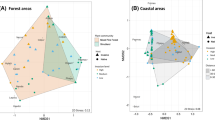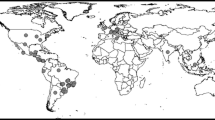Abstract
Biological invasions are regarded as a major threat to native biodiversity, with cascading ecological and economic consequences within invaded areas. Anticipating and managing these invasions requires a better understanding of the interactions between non-native and native species. We compiled a list of alien plant species and their native insect herbivores from various terrestrial habitats in the Kashmir Himalaya. On alien plants, a total of 15 native insect herbivores were found, four of which were specialists (Aglais caschmirensis on Urtica dioica, Agrotis sp. and Chrysolina herbacea on Mentha longifolia and Nezara viridula on Verbascum thapsus) and the rest were generalists. Altica himensis is the most common native insect herbivore, feeding on nearly 31 alien plants. Various diversity indices show a quantitative estimate of the alien plant and native insect herbivore network. A total of 42 alien plants were recorded throughout the course of 2 years (2018–2020), with Plantago major having the highest relative abundance of 9.7. The study provides a baseline information on the challenging issue of biological invasion by highlighting the role of native insect herbivores as natural biocontrol agents against invasive alien plants.








Similar content being viewed by others
Data availability
Data sharing not applicable to this article as no datasets were generated or analysed during the current study. The datasets analysed are field-based studies of the authors.
Code availability
Not applicable.
References
Maron JL, Vila M (2001) When do herbivores affect plant invasion? Evidence for the natural enemies and biotic resistance hypothesis. Oikos 95:361–373
McFadyen REC (1998) Biological control of weeds. Ann Rev of Ento 43:369–393
Mehraj G, Khuroo AA, Qureshi S, Muzafar I, Friedman CR, Rashid I (2018) Patterns of alien plant diversity in the urban landscapes of global biodiversity hotspots: a case study from the Himalayas. Bio and Cons 27(5):1055–1072
Messing HR, Wright MG (2006) Biological control of invasive species: solution or pollution? Front Ecol Environ 4(3):132–140
Mills NJ (1994) Parasitoid guilds: a comparative analysis of the parasitoid communities of tortricids and weevils. In: Hawkins BA (ed) Parasitoid community ecology. University of California, Berkeley
Mitchell CE, Agrawal AA, Bever JD, Gilbert GS (2006) Biotic interactions and plant invasions ecology. Letters 9:726–740
Moran VC, Hoffmann JH, Zimmermann HG (2005) Biological control of invasive alien plants in South Africa: necessity, circumspection, and success. Front Ecol Environ 3:71–77
Oliver AD, Chapin JB (1981) Biology and illustrated key for the identification of twenty species of economically important noctuid pests. LSU Agr Exp Stat Rep 1981:26
Parker JD, Hay ME (2005) Biotic resistance to Plant invasions? Native herbivores prefer non-native plants. Eco Lett 8:959–967
Parker JD, Burkepile DE, Hay ME (2006) Opposing effects of native and exotic herbivores on plant invasions. Science 311:1459–1461
Pearse IS, Hipp AL (2014) Native plant diversity increases herbivory to non-natives. Proc of the Royal Soc of Lon B 281:18–41
Pearson DE, Callaway RM (2006) Indirect effects of host-specific biological control agents. Trends in Eco Evo 18:456–461
Pimentel D (ed) (2002) Biological invasion: economic and environmental costs of alien plant, animal, and microbe species. CRC Press, Boca Raton
Porter P (2018) Grasshopper. Extension entomology.
Prather T, Peachey E (2022) Control of problem weeds, Section Y. p 4
Rather BA, Hussain B, Mir GM (2017) Seasonal incidence and biodiversity of flea beetles (Coleoptera, Alticinae) in a brassicaceous vegetable agro-ecosystem of Kashmir valley. Bio One 127(3):252–268
Razak N, Ahmad I (2020) Diversity of insects infesting medicinal and aromatic plants in the Kashmir Valley. In: Din R (ed) Biodiversity of the Himalaya: Jammu and Kashmir State. Springer, Singapore
Reddy CS (2008) Catalogue of invasive alien flora of India. Life Sci J 5:84–89
Ricciardi A, Hoopes MF, Marchetti MP, Lockwood JL (2013) Progress toward understanding the ecological impacts of non-native species. Ecol Monographs 83:263–282
Rodgers WA, Panwar HS (1988) Planning a wild life protected area network in India. Biodivers Conserv 17:2495
Rodriguez J, Cordero-Rivera A, Gonzalez L (2021) Impacts of the invasive plant Carpobrotus edulis on herbivore communities on the Iberian Peninsula. Biol Inva 23(5):1425–1441
Routledge RD (1980) Bias in estimating the diversity of large, uncensused communities. Ecology 61:276–281
Schoville SD, Chen YH, Andersson MN (2018) A model species for agricultural pest genomics: the genome of the Colorado potato beetle, Leptinotarsa decemlineata (Coleoptera: Chrysomelidae). Sci Rep 8:1931
Schowalter TD (2017) Insect ecology. An ecosystem approach. 4th edition, ©Academic Press,Cambridge. https://doi.org/10.1016/C2014-0-04067-1
Schowalter TD (2022) Insect ecology. An ecosystem approach. Academic Press, Cambridge
Sekar CK, Manikandan R, Srivastava SK (2012) Invasive alien plants of Uttarakhand Himalaya. Proc of the Natl Acad of Sci India Sect B: Biol Sci 82(3):375–383
Shajahan S, Sivarajan S, Maharlooei M, Bajwa SG, Harmon JP, Nowatzki JF, Cannayen I (2017) Identification and counting of soybean aphids from digital images using shape classification. Trans ASABE 60(5):1467–1477
Simberloff D (1992) Conservation of pristine habitats and unintended effects of biological control. In: Kauffman WC, Nechols JE (eds) Selection criteria and ecological consequences of importing natural enemies. Entomological Society of America, Lanham, pp 103–117
Torchin ME, Mitchell CE (2004) Parasites, pathogens, and invasions by plants and animals. Front in Eco and Env 2:183–190
van Klinken RD, Edwards OR (2002) Is host specificity of weed biological control agents likely to evolve rapidly following establishment? Eco. Lett. 5:590–596
Vila M, Espinar JL, Hejda M, Hulme PE, Jarosik V (2011) Ecological impacts of alien alien plants: a meta-analysis of their effects on species, communities and ecosystems. Eco Letters 14:702–708
Von HB (2011) Invasional meltdown. In: Simberloff D, Rejmanek M (eds) Encyclopedia of alien introduced species. University of California Press, Berkeley, CA, pp 360–364
Wittenberg R, Cock MJW (2001) Alien alien species: a toolkit of best prevention and management practices. CAB International, Wallingford, Oxon, UK
Ahmad M, Faisal M (2012) Status of insect pests of poplar in India with special reference to Clostera spp. For Bull 12(1):105–122
Ali JG, Agrawal AA (2012) Specialist versus generalist insect herbivores and plant defense. Tren in Plant Sci 17(5):293–302
Bennet-clark HC (1975) The energetics of the jump of the locust Schistocerca gregaria. J of Exp Bio 63(1):53–83
Bhat MA (2008) A report on insect-pests associated with cole crops in Kashmir. Appl Bio Res 10:66–67
Bhat DM (2017) First report of Rumex acetosa L as a host plant of Altica himensis Shukla (Coleoptera: Chrysomellidae) from Kashmir. J Adv Zool 38(1):79–81
Bhat DM, Ahanger FA (2018) A systematic checklist and species richness of insect pests associated with vegetable crops in Jammu & Kashmir State (India). J of Ento and Zoo Stu 6(2):328–338
Bienkowski AO (2001) A study on the genus Chrysolina Motschulsky, 1860, with a checklist of all the described subgenera, species, subspecies, and synonyms (Coleoptera: Chrysomelidae: Chrysomelinae). Genus 12(2):105–235
Boettner GG, Elkinton JS, Boettner CJ (2000) Effects of a biological control introduction on three nontarget native species of Saturniid moths. Cons Bio 14:1798–1806
Borowiec L (1989) Three new species of Charidotella Weise (Coleoptera, Chrysomelidae, Cassidinae), with checklist of the genus. Pol Pis Ento 59:203–222
Buschman LL (1980) Parasites of Nezara viridula (Hemiptera: Pentatomidae) and other Hemiptera in Florida. Flor Ento 63:154–162
Calatayud PA, Sauvion N, Thiéry D, Rebaudo F, Jacquin-Joly E (2018) Plant-insect interactions. Ecology. Oxford University Press, Oxford
Carvalheiro LG, Buckley YM, Ventim R, Fowler SV, Memmott J (2008) Apparent competition can compromise the safety of highly specific biocontrol agents. Ecol Lett 11:690–700
Culliney TW (2005) Benefits of classical biological control for managing alien plants. Cri Rev in Plant Sci 24:131–150
Demirel N, Cranshaw W (2006) Surveys of False Chinch Bug, Nysius raphanus (Howard) (Hemiptera: Lygaeidae) and their movement on cultivated crops. J of Ento 3(2):149–155
Diagne C, Leroy B, Vaissieere AC, Gozlan RE, Roiz D, Jaric I, Salles JM, Bradshaw CJA, Courchamp F (2021) High and rising economic costs of biological invasions worldwide. Nature 592:571–576
Elton CS (1958) The ecology of invasions by animals and plants. Methuen, London
Gols R, Bukovinszky T, Van Dam NM, Dicke M, Bullock JM, Harvey JA (2008) Performance of generalist and specialist herbivores and their endoparasitoids differs on cultivated and wild Brassica populations. J of Chem Ecol 34(2):132–143
Greathead DJ (1995) Chapter 5: benefits and risks of classical biological control. In: Hokkanen HMT, Lynch JM (eds) Biological control benefits and risks. Cambridge University Press, Cambridge, UK, pp 53–63
Halbritter AH, Carroll GC, Gusewell S, Roy BA (2012) Testing assumptions of the enemy release hypothesis: generalist versus specialist enemies of the grass Brachypodium sylvaticum. Mycologia 104:34–44
Hart DD, Horwitz RJ (1991) Habitat diversity and the species area relationship, alternative models and tests. In: Bell SS, Mc Coy ED, Mursshinshy HR (eds) Habitat structure: the physical arrangement of objects in space. Chapman and Hall, London
Henneman ML, Memmott J (2001) Infiltration of a Havaiian community by introduced biological control agents. Science 17:1314–1316
Howarth FG (1991) Environmental impacts of classical biological control. Ann Rev of Ento 36:485–509
Keane RM, Crawley MJ (2002) Exotic plant invasions and the enemy release hypothesis. Trend Eco Evol 17:164–170
Kelly CA, Bowers MD (2016) Preference and performance of generalist and specialist herbivores on chemically defended host plants. Ecol Entom 41(3):308–316
Khuroo AA, Rashid I, Reshi Z, Dar GH, Wafai BA (2007) The Alien flora of Kashmir Himalaya. Biol Invasions 9:269–292
Khuroo AA, Reshi ZA, Rashid I, Dar GH, Khan ZS (2008) Operational characterization of alien flora and its management implications. Bio Cons 17:3181–3194
Khuroo AA, Weber E, Reshi ZA, Malik AH, Dar GH (2011) Altitudinal distribution patterns of the native and alien woody flora in Kashmir Himalaya. India Environ Res 111:967–977
Khuroo AA, Reshi ZA, Malik AH, Weber E, Rashid I, Dar GH (2012) Alien fora of India: taxonomic composition, invasion status and biogeographic affiliations. Biol Invasions 14(1):99–113
Knodel JJ (2017) Flea beetles (Phyllotreta spp) and their management. Integrated management of insect pests on canola and other brassica oilseed crops. CABI, Wallingford
Kriti JS, Dar MA, Khan ZH (2014) Biological and taxonomic study of agriculturally important noctuid pests of Kashmir. World J of Agr Res 2(2):82–87
Liu H, Stiling P, Pemberton RW, Penainsect J (2006) Herbivore faunal diversity among invasive, non-invasive and native eugenia species: implications for the enemy release hypothesis. Flori Ento 89(4):475–484
Liu Y, Fu X, Mao L, Xing Z, Wu K (2016) Host plants identification for adult Agrotis ipsilon, a long-distance migratory insect. Int J Mol Sci 17(6):851–853
Louda S, Kendall D, Connor J, Simberloff D (1997) Ecological effects of an insect introduced for the biological control of weeds. Science 277:1088–1090
Louda SM, Arnett AE, Rand TA, Russell FL (2003) Invasiveness of some biological control insects and adequacy of their ecological risk assessment and regulation. Conserv Biol 17:73–82
Lu X, Siemann E, He M, Wei H, Shao X, Ding J (2015) Climate warming increases biological control agent impact on a non-target species. Ecol Lett 18:48–56
Acknowledgements
An earlier draft of the manuscript received critical review from two anonymous reviewers, which significantly improved its quality. Financial support by DST-SERB, Government of India, New Delhi, under major research grant, vide file no. EMR/2017/000215 is gratefully acknowledged. Authors also extend their gratitude to Dr. Khuroo and Dr. Malik, Centre of Biodiversity, University of Kashmir for their assistance in identification of alien plant species.
Funding
Department of Science and Technology, Science and Engineering Research Board, Vide file no. EMR/2017/000215.
Author information
Authors and Affiliations
Corresponding author
Ethics declarations
Conflicts of interest
The authors declare that we do not have any conflicts of interest.
Ethical approval
Not applicable.
Informed consent
Not applicable.
Consent for publication
Not applicable.
Additional information
Handling Editor: Livy Williams.
Publisher's Note
Springer Nature remains neutral with regard to jurisdictional claims in published maps and institutional affiliations.
Rights and permissions
Springer Nature or its licensor holds exclusive rights to this article under a publishing agreement with the author(s) or other rightsholder(s); author self-archiving of the accepted manuscript version of this article is solely governed by the terms of such publishing agreement and applicable law.
About this article
Cite this article
Ahmad, T., Rashid, I., Ahmad, R. et al. Alien plant and native herbivore network of Kashmir Himalaya. Arthropod-Plant Interactions 16, 423–435 (2022). https://doi.org/10.1007/s11829-022-09916-x
Received:
Accepted:
Published:
Issue Date:
DOI: https://doi.org/10.1007/s11829-022-09916-x




